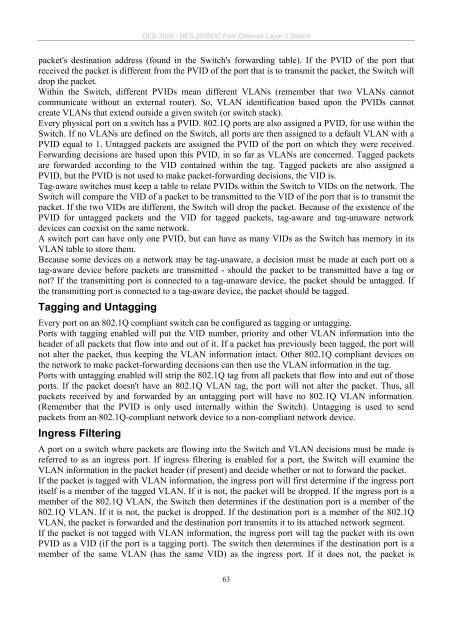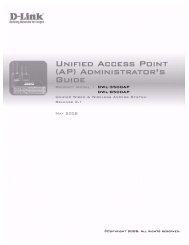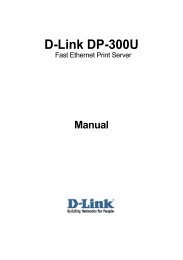Product Manual
Product Manual
Product Manual
Create successful ePaper yourself
Turn your PDF publications into a flip-book with our unique Google optimized e-Paper software.
DES-3526 / DES-3526DC Fast Ethernet Layer 2 Switch<br />
packet's destination address (found in the Switch's forwarding table). If the PVID of the port that<br />
received the packet is different from the PVID of the port that is to transmit the packet, the Switch will<br />
drop the packet.<br />
Within the Switch, different PVIDs mean different VLANs (remember that two VLANs cannot<br />
communicate without an external router). So, VLAN identification based upon the PVIDs cannot<br />
create VLANs that extend outside a given switch (or switch stack).<br />
Every physical port on a switch has a PVID. 802.1Q ports are also assigned a PVID, for use within the<br />
Switch. If no VLANs are defined on the Switch, all ports are then assigned to a default VLAN with a<br />
PVID equal to 1. Untagged packets are assigned the PVID of the port on which they were received.<br />
Forwarding decisions are based upon this PVID, in so far as VLANs are concerned. Tagged packets<br />
are forwarded according to the VID contained within the tag. Tagged packets are also assigned a<br />
PVID, but the PVID is not used to make packet-forwarding decisions, the VID is.<br />
Tag-aware switches must keep a table to relate PVIDs within the Switch to VIDs on the network. The<br />
Switch will compare the VID of a packet to be transmitted to the VID of the port that is to transmit the<br />
packet. If the two VIDs are different, the Switch will drop the packet. Because of the existence of the<br />
PVID for untagged packets and the VID for tagged packets, tag-aware and tag-unaware network<br />
devices can coexist on the same network.<br />
A switch port can have only one PVID, but can have as many VIDs as the Switch has memory in its<br />
VLAN table to store them.<br />
Because some devices on a network may be tag-unaware, a decision must be made at each port on a<br />
tag-aware device before packets are transmitted - should the packet to be transmitted have a tag or<br />
not? If the transmitting port is connected to a tag-unaware device, the packet should be untagged. If<br />
the transmitting port is connected to a tag-aware device, the packet should be tagged.<br />
Tagging and Untagging<br />
Every port on an 802.1Q compliant switch can be configured as tagging or untagging.<br />
Ports with tagging enabled will put the VID number, priority and other VLAN information into the<br />
header of all packets that flow into and out of it. If a packet has previously been tagged, the port will<br />
not alter the packet, thus keeping the VLAN information intact. Other 802.1Q compliant devices on<br />
the network to make packet-forwarding decisions can then use the VLAN information in the tag.<br />
Ports with untagging enabled will strip the 802.1Q tag from all packets that flow into and out of those<br />
ports. If the packet doesn't have an 802.1Q VLAN tag, the port will not alter the packet. Thus, all<br />
packets received by and forwarded by an untagging port will have no 802.1Q VLAN information.<br />
(Remember that the PVID is only used internally within the Switch). Untagging is used to send<br />
packets from an 802.1Q-compliant network device to a non-compliant network device.<br />
Ingress Filtering<br />
A port on a switch where packets are flowing into the Switch and VLAN decisions must be made is<br />
referred to as an ingress port. If ingress filtering is enabled for a port, the Switch will examine the<br />
VLAN information in the packet header (if present) and decide whether or not to forward the packet.<br />
If the packet is tagged with VLAN information, the ingress port will first determine if the ingress port<br />
itself is a member of the tagged VLAN. If it is not, the packet will be dropped. If the ingress port is a<br />
member of the 802.1Q VLAN, the Switch then determines if the destination port is a member of the<br />
802.1Q VLAN. If it is not, the packet is dropped. If the destination port is a member of the 802.1Q<br />
VLAN, the packet is forwarded and the destination port transmits it to its attached network segment.<br />
If the packet is not tagged with VLAN information, the ingress port will tag the packet with its own<br />
PVID as a VID (if the port is a tagging port). The switch then determines if the destination port is a<br />
member of the same VLAN (has the same VID) as the ingress port. If it does not, the packet is<br />
63

















